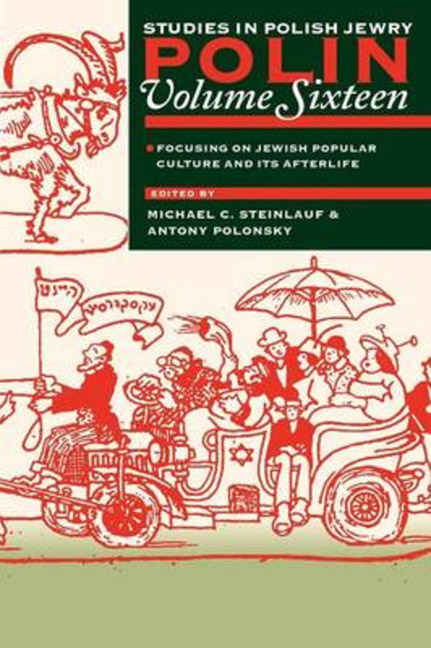Book contents
- Frontmatter
- Dedication
- Editors and Advisers
- Preface
- Polin
- Polin: Studies in Polish Jewry
- Contents
- Note on Place Names
- Note on Transliteration
- PART I JEWISH POPULAR CULTURE IN POLAND AND ITS AFTERLIFE
- IN PRE-WAR POLAND
- The Badkhn: From Wedding Stage to Writing Desk
- Remembrance of Things Past: Klezmer Musicians of Galicia, 1870–1940
- Early Recordings of Jewish Music in Poland
- Jewish Theatre in Poland
- A Tuml in the Shtetl: Khayim Betsalel Grinberg's Di khevre-kedishe sude
- Mordechai Gebirtig: The Folk Song and the Cabaret Song
- Simkhe Plakhte: From ‘Folklore’ to Literary Artefact
- Between Poland and Germany: Jewish Religious Practices in Illustrated Postcards of the Early Twentieth Century
- Papers for the Folk: Jewish Nationalism and the Birth of the Yiddish Press in Galicia
- Shund and the Tabloids: Jewish Popular Reading in Inter-War Poland
- Dos yidishe bukh alarmirt! Towards the History of Yiddish Reading in Inter-War Poland
- Exploiting Tradition: Religious Iconography in Cartoons of the Polish Yiddish Press
- AFTERLIFE
- PART II DOCUMENTS
- PART III NEW VIEWS
- PART IV REVIEWS
- REVIEW ESSAYS
- BOOK REVIEWS
- CORRESPONDENCE
- OBITUARIES
- Notes on the Contributors
- Glossary
- Index
The Badkhn: From Wedding Stage to Writing Desk
from IN PRE-WAR POLAND
- Frontmatter
- Dedication
- Editors and Advisers
- Preface
- Polin
- Polin: Studies in Polish Jewry
- Contents
- Note on Place Names
- Note on Transliteration
- PART I JEWISH POPULAR CULTURE IN POLAND AND ITS AFTERLIFE
- IN PRE-WAR POLAND
- The Badkhn: From Wedding Stage to Writing Desk
- Remembrance of Things Past: Klezmer Musicians of Galicia, 1870–1940
- Early Recordings of Jewish Music in Poland
- Jewish Theatre in Poland
- A Tuml in the Shtetl: Khayim Betsalel Grinberg's Di khevre-kedishe sude
- Mordechai Gebirtig: The Folk Song and the Cabaret Song
- Simkhe Plakhte: From ‘Folklore’ to Literary Artefact
- Between Poland and Germany: Jewish Religious Practices in Illustrated Postcards of the Early Twentieth Century
- Papers for the Folk: Jewish Nationalism and the Birth of the Yiddish Press in Galicia
- Shund and the Tabloids: Jewish Popular Reading in Inter-War Poland
- Dos yidishe bukh alarmirt! Towards the History of Yiddish Reading in Inter-War Poland
- Exploiting Tradition: Religious Iconography in Cartoons of the Polish Yiddish Press
- AFTERLIFE
- PART II DOCUMENTS
- PART III NEW VIEWS
- PART IV REVIEWS
- REVIEW ESSAYS
- BOOK REVIEWS
- CORRESPONDENCE
- OBITUARIES
- Notes on the Contributors
- Glossary
- Index
Summary
INTRODUCTION
IN this chapter I discuss two key roles of the traditional Jewish entertainer known as the badkhn: as a performer on the wedding stage (bimah) at Jewish weddings and as the author of published versions of such performances. My goal is to examine, first, the badkhn's techniques of expression and, secondly, the process through which, beginning in the mid-nineteenth century, the badkhn's work began to move from oral performance to written literature.
The badkhn first emerged in Europe during the Middle Ages alongside comparable artists among other peoples. As Jewish society and Judaism evolved from the sixteenth century to the end of the nineteenth century, the badkhn adapted himself to the changing conditions. By the nineteenth century his identity had crystallized into that of a figure with two faces: one of riotous, chaotic, topsy-turvy jesting, rooted in ancient sacrificial traditions surrounding the god Dionysus and evincing a tendency towards social subversiveness; and the other of conservative, learned discourse rooted in the fixed system of halakhic mitsvot and serving as a mouthpiece for them.
The popular poetry of the badkhonim is noted for its simplicity, the language closely identified with the spoken idiom of ordinary people. Yet at the foundation of the badkhn's poetry the holy, elevated language of the Bible is present in varying degrees. Alongside the prosaic features of this poetry are the repetitive sounds of rhyme, a widespread by-product of the strong rhythms that characterize oral art.
The art of the badkhn could not be expressed in isolation. It was meaningless without the participation in the artist's performance of those watching and hearing him. Because the encounter between the badkhn and his audience occurred at specific special events—family gatherings or holidays—the audience usually gathered for the event and not specifically to see the badkhn. None the less, the badkhn usually led the event and was at the centre of the celebration, though the audience was also active, often no less than the badkhn. Consequently, the badkhn had two possible approaches, not entirely distinct from each other, to participating in the event: he could allow himself to be swept up by the celebration and spontaneously follow the needs of his audience, their wishes and mood, or he could organize the event at the outset and play a more central role in determining its course.
- Type
- Chapter
- Information
- Focusing on Jewish Popular Culture and Its Afterlife , pp. 7 - 28Publisher: Liverpool University PressPrint publication year: 2003

